
The visit by the president of the Cabildo, Rosa Dávila, alongside Metroenife‘s counsellor for Mobility, Eulalia García, centred on the development of the Pink line, which inspires the execution of the underground works for the South train in the section near Reina Sofía Airport. The Tenerife representatives familiarised themselves with the operational strategies of the Metro do Porto, including the intermodality of public transport, funding structures, and the planning of diverse infrastructures.
Construction
The Pink line represents a railway project encompassing four underground stations over a distance of 3.1 kilometres, currently in an advanced stage of construction. The anticipated demand is expected to exceed 30 million passengers per kilometre during its inaugural year of operation, leading to an approximate reduction of 1,500 tonnes of CO₂ annually.
Insights
Rosa Dávila stated, “The Oporto experience demonstrates that a rail system only succeeds when designed from an intermodal viewpoint.” She further remarked, “It is insufficient to merely construct a train; it is crucial to integrate it with guaguas, transport to the airport, and shared mobility. This is our vision for Tenerife.” Porto serves as a European benchmark in rail mobility, a model that Dávila and García learned about firsthand. Their goal was to evaluate this experience and consider its potential application in the development of both the South and North Trains, as well as the expansion of tram lines.
Technical Team
The president and counsellor were joined by the technical team of the Tenerife Railway Company, aligned with the Cabildo’s strategy to provide a structural solution to a long-standing issue: road congestion on the island. With a firm commitment to infrastructure that enhances mobility, reduces reliance on private vehicles, and fosters improved air quality, the institution reaffirms its dedication to a more sustainable and efficient transport model.
Agenda
The Tenerife delegation engaged in an intensive work agenda, visiting various pivotal points of the Porto transport system. Their initial meeting was with the president of Porto Metro, Tiago Filipe da Costa Braga, and his management team, focusing on key aspects such as evolution, growth, and the financing model. The president explained that Porto Metro has witnessed exceptional growth recently, reaching a record transportation figure of approximately 89.78 million passengers in 2024, representing a 13.6% increase from the 79 million recorded in 2023. The network, spanning 67 kilometres and 81 stations, links the city with surrounding municipalities to enhance regional mobility.
Subterranean Works
Following this, the delegation proceeded to tour the construction site of the pink line, a new underground rail facility currently at an advanced construction phase. This initiative entails the creation of four underground stations and three ventilation shafts, alongside the installation of tracks, catenary systems, and other requisite equipment. During the site visit, Cabildo representatives observed the excavation techniques employed, particularly the usage of tunnel boring machines and traditional drilling methods in specific sections. This combination ensures structural stability while minimising surface impact, thereby alleviating disturbances for residents and local businesses. Rosa Dávila emphasised that “these types of solutions allow us to progress towards a modern transport system, tailored to the needs of the populace and in line with the standards of sustainability and efficiency we aspire to for Tenerife.”
Intermodality
One of the most notable aspects of the visit was the intermodality within the Porto transport system. The ability to seamlessly connect various modes of transport such as the light metro, trains, urban and interurban guaguas, and air transport is essential. This synergy, according to the president of Metron Tenerife, “is vital to provide efficient and accessible mobility. This integration is realised through intermodal stations and a unified transport card, similar to what we already utilise in Tenerife, streamlining transfers.”
Projects
The delegation also toured the EMEF facilities (Manutenção de Ferroviario, SA) in Guifões, which is one of Portugal’s most significant railway infrastructures devoted to the maintenance and modernisation of rolling stock. In addition, they learned about the Rapid Transit (BRT) Bus initiative in Porto, boasting a 3.8-kilometre route, designed to enhance mobility in low-demand corridors. Specifically, they inspected Casa Da Musica, which will serve as the primary operations centre for the new Metrobus system in Porto. This system is projected to commence operations in the summer of 2025, following the delivery and testing of the Hydrogen articulated vehicles.














